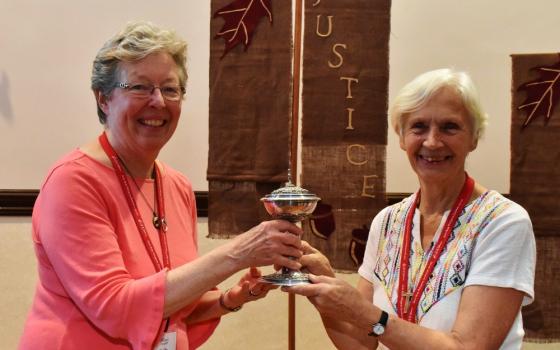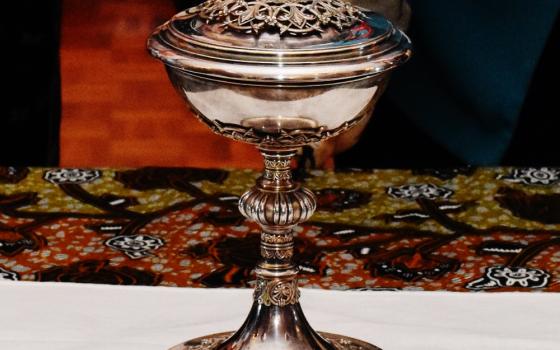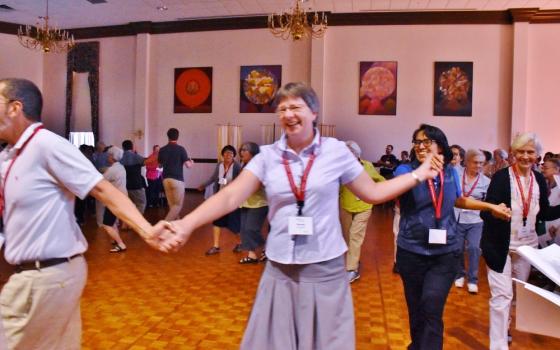The precious object was processed to the middle of room, surrounded by 350 of us, sisters and friends of the Society of the Sacred Heart. Held by a sister from Venezuela, the silver vessel glowed as its accompanying letter was read. The provincial of Venezuela offered the ciborium as a gift to our United States-Canada province, a sign of friendship among the sisters of South and North America. Witnesses to the intimacy of this gift of communion, we were all moved by the generosity of the sisters of Venezuela, which arose out of their great poverty and suffering. When the provincial's words had been read, the ciborium was placed on the altar, and we joined our hearts together in the Liturgy of the Eucharist.
This special ceremony on July 15, 2017, was not the first time the ciborium had been used in our city, St. Louis, Missouri. It first arrived in the area in 1818, carried by St. Rose Philippine Duchesne as a holy and precious gift from her friend, St. Madeleine Sophie Barat. As Philippine's religious superior and intimate friend, Sophie sent her in mission to the Americas, bearing the ciborium as a receptacle for her friendship, their shared missionary zeal, and the Body of Christ which united them even at such a distance.
The friendship between Sophie and Philippine went far beyond that of mother general to one of her own sisters. Philippine, "daughter" to Sophie though 10 years older, was a close spiritual companion for the foundress of her order, who felt free to reveal the desires of her heart to Philippine. Sophie knew that Philippine, like her, had a missionary vocation, and so she entrusted the mission of the Society of the Sacred Heart in North America to Philippine's leadership. Because of their mutual trust and interdependent gifts — Sophie for her ability to hold a unified center through her leadership, and Philippine for her willingness to engage in courageous exploration — the Society spread far and wide and always remained faithful to the center back in France.
The ciborium's first journey to the new world with Philippine did not end in Missouri, where Philippine established the Academy of the Sacred Heart in St. Charles, the first Sacred Heart school in the New World. While the details are sketchy, eventually it made its way to the convent in New York, and from there was sent with the first Religious of the Sacred Heart missionaries to Cuba in 1858. The Cuban community held the ciborium until the communist regime made Sacred Heart education unwelcome in 1961, and the sisters moved from there to Puerto Rico for a few months. Finally, sisters from Puerto Rico and Cuba were sent to Venezuela to establish a new foundation. Since then, the ciborium had been in Venezuela, forgotten by the Religious of the Sacred Heart sisters in the United States.
The friendship of these two saints models for us the friendship that holds our congregation as one. Philippine, though far away in North America, relied on Sophie's vision of the society as she expanded into new areas, established new houses, and welcomed American novices. Though the context of the United States remained very different from that of France, Philippine knew Sophie's leadership well enough to assure continuity with the center. They carried on a lively correspondence, hampered by unreliable mail service in the frontier lands of Missouri.
Today, as our congregation re-shapes relationships among provinces, the sisters throughout North and South America are united in one region, named for Philippine Duchesne. This is in spite of the fact that friendship among the members of these provinces suffered through the political tensions of the 20th century.
Sisters today remember the high tensions of the Cuban Missile Crisis, the U.S. government's support of Latin American authoritarian regimes, free trade agreements that favored the subsidized farmers of the United States, and U.S. companies' proliferation of genetically modified seeds that are destructive to traditional farming practices. The policy-centered tensions continue today with discrimination against migrants, closed borders and walls, and politically-fostered fear of the "other."
Yet, it is at this moment that our provinces are coming together in the Philippine Region. After many years of tension, we are overcoming our differences to recognize our shared humanity. As members of the Society of the Sacred Heart, we sisters share a charism to spread God's love in our world. This charism demands of us to rely on one another. A new spirit of charity has emerged, allowing us to see one another rather than to see the nation the other represents. In the U.S., we are recognizing our poverty in so many new ways, ways that material possessions cannot solve.
The nation of Venezuela — a nation in turmoil and economic poverty at this moment — has offered us, the sisters in the United States, a precious vessel of friendship and Eucharistic union. This relic of two saints, who recognized in one another a spiritual friendship centered on the love of Jesus, reminds us of the unity we are drawn into when we receive the Eucharist.
Just as Philippine and Sophie represent complementary gifts of mission, which together allowed for extraordinary acts that neither could have accomplished without the other, we too must rely on one another in the Body of Christ. Standing united by the Eucharist, we rely on the gifts of one another to draw ever closer to God's dream and our shared mission.
Sisters and friends, representing the Sacred Heart family in 41 countries, we united our hearts and voices in the celebration of the Eucharist. As the crowd danced and sang the recessional, several of us stood by the altar, drawn by the ciborium's magnetism. The powerful witness of friendship, mission to far-off lands, and the holiness — and wholeness — of the Body of Christ brought tears to our eyes. In that moment, we felt ourselves united and transformed by God's love.
You can visit rscj.org/bicentennial2018 for events and resources surrounding the 200th anniversary of the arrival of Philippine in the New World.
[Juliet Mousseau, a member of the Society of the Sacred Heart community, is associate professor of church history at the Aquinas Institute of Theology in St. Louis.]



